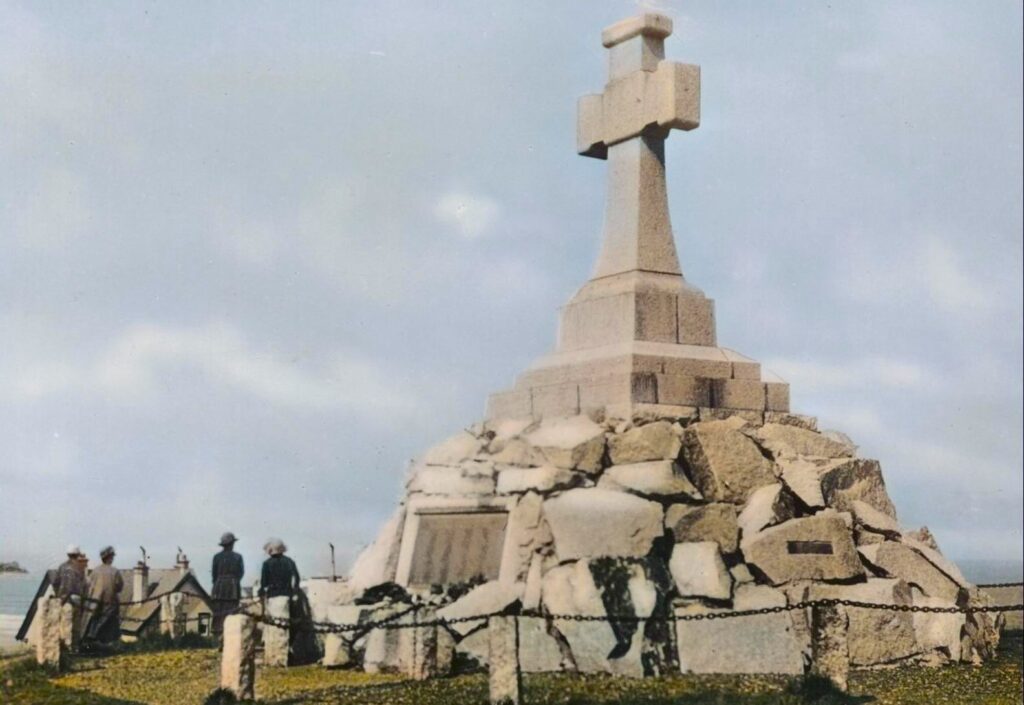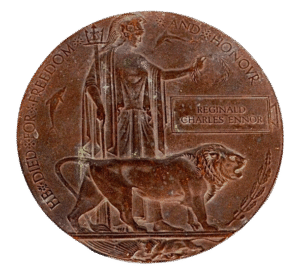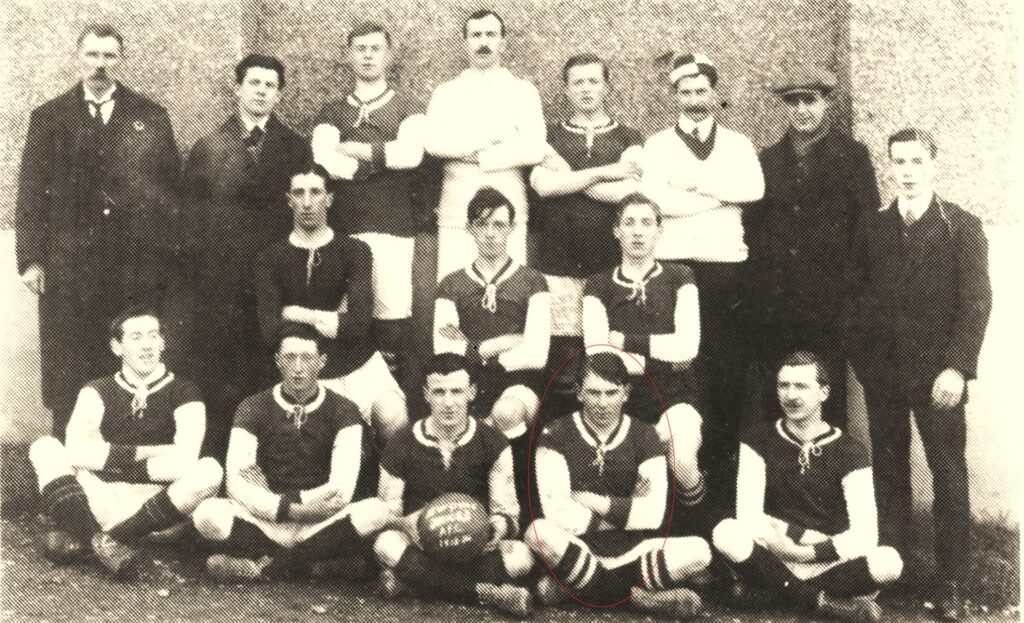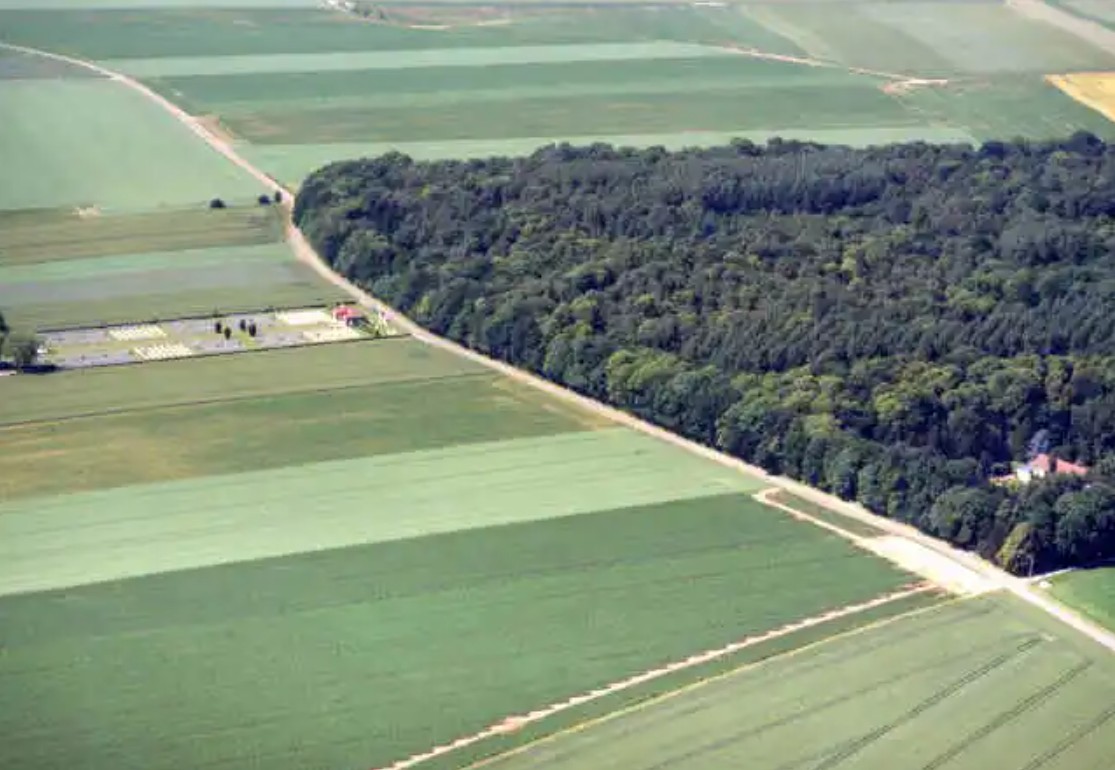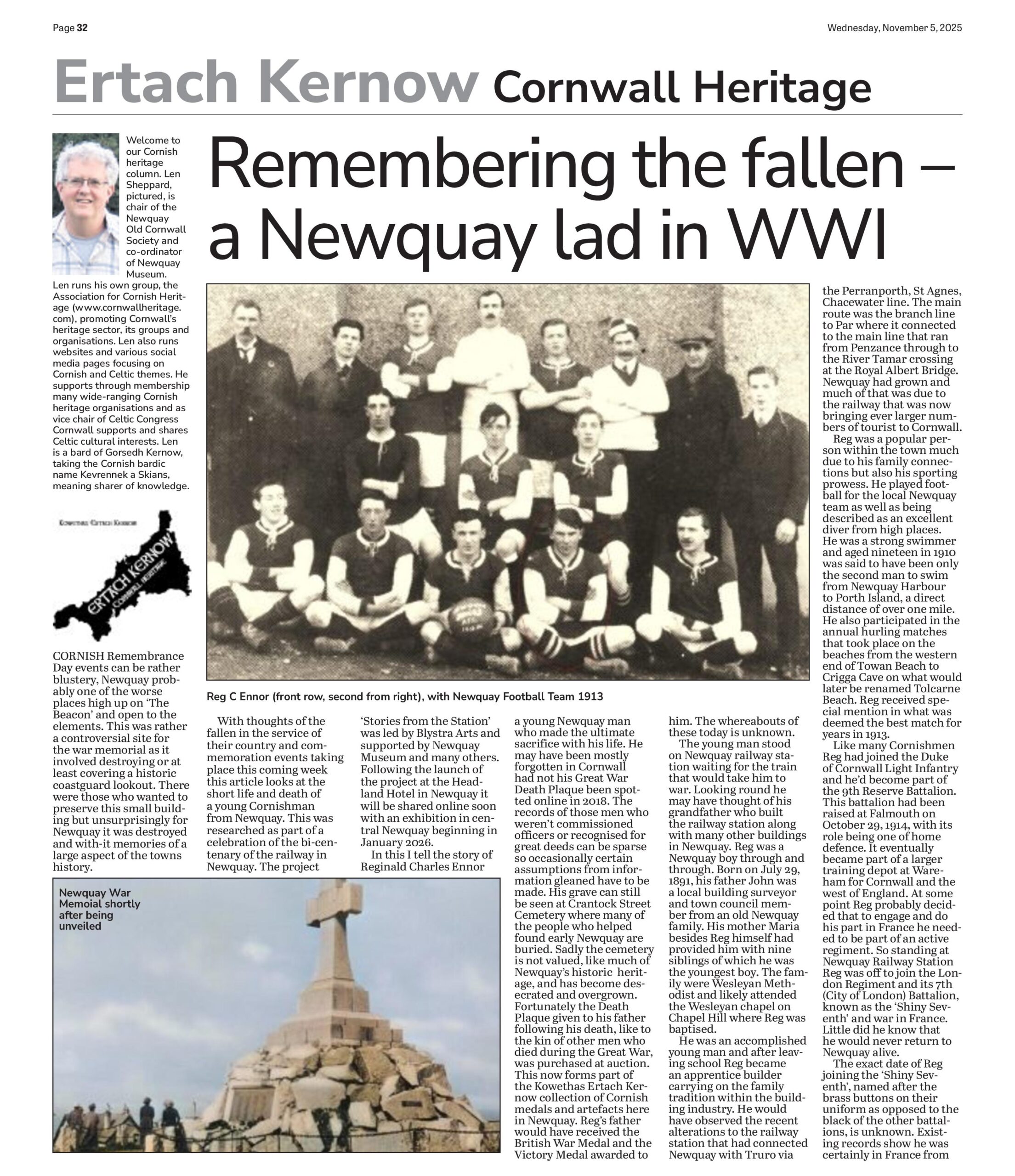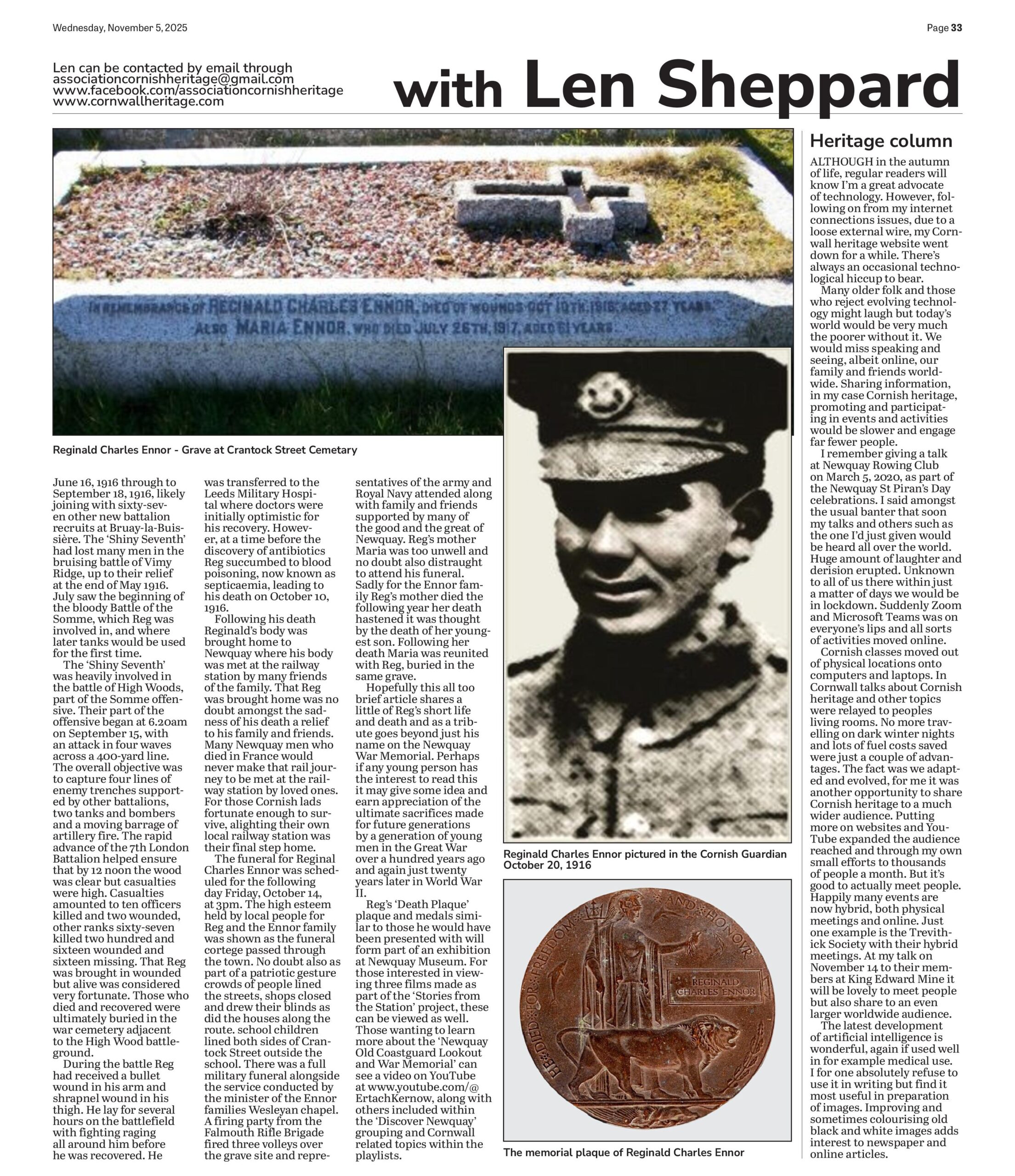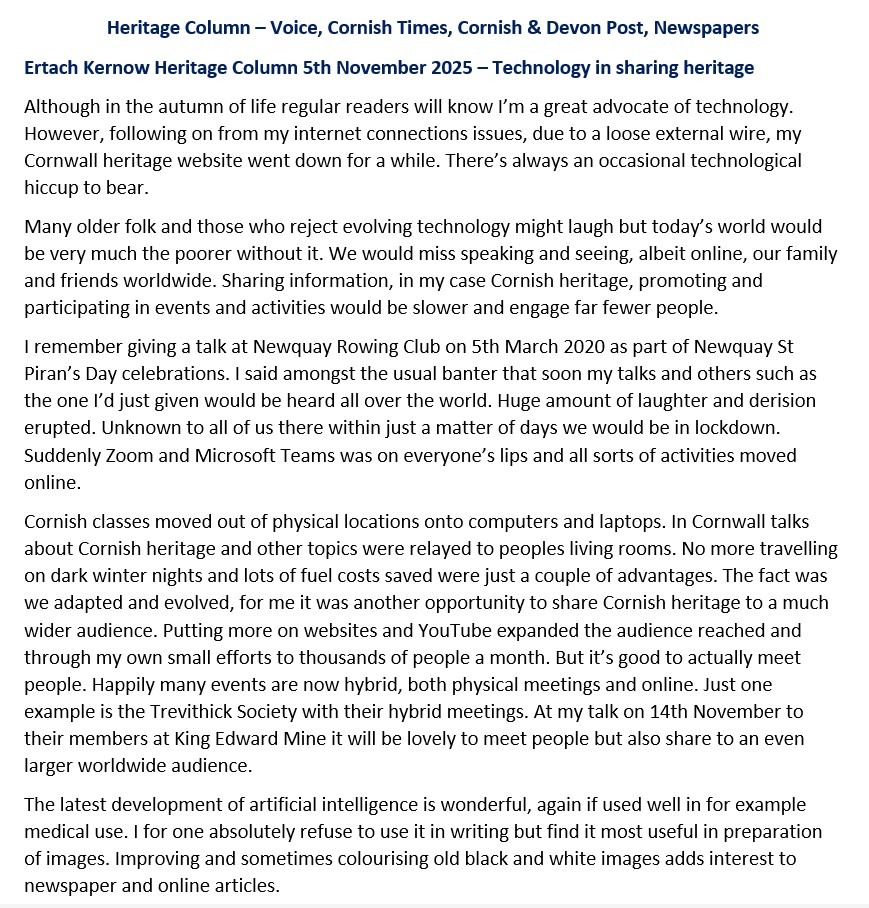Ertach Kernow - Remembering the fallen a Newquay lad in WWI
Remembering the fallen
Cornish remembrance day events can be rather blustery, Newquay probably one of the worse places high up on ‘The Beacon’ and open to the elements. This was rather a controversial site for the war memorial as it involved destroying or at least covering a historic coastguard lookout. There were those who wanted to preserve this small building but unsurprisingly for Newquay it was destroyed and with-it memories of a large aspect of the towns history.
With thoughts of the fallen in the service of their country and commemoration events taking place this coming week this article looks at the short life and death of a young Cornishman from Newquay. This was researched as part of a celebration of the bi-centenary of the railway in Newquay. The project ‘Stories from the Station’ was led by Blystra Arts and supported by Newquay Museum and many others. Following the launch of the project at the Headland Hotel in Newquay it will be shared online soon with an exhibition in central Newquay beginning in January 2026.
Thank you for reading the online version of the Ertach Kernow weekly articles. These take some 12 hours each week to research, write and then upload to the website, and is unpaid. It would be most appreciated if you would take just a couple of minutes to complete the online survey marking five years of writing these weekly articles. Many thanks.
Click the link for survey: Ertach Kernow fifth anniversary survey link
As always click the images for larger view
In this I tell the story of Reginald Charles Ennor a young Newquay man who made the ultimate sacrifice with his life. He may have been mostly forgotten in Cornwall had not his Great War Death Plaque been spotted online in 2018. The records of those men who weren’t commissioned officers or recognised for great deeds can be sparse so occasionally certain assumptions from information gleaned have to be made. His grave can still be seen at Crantock Street Cemetery where many of the people who helped found early Newquay are buried. Sadly the cemetery is not valued, like much of Newquay’s historic heritage, and has become desecrated and overgrown. Fortunately the Death Plaque given to his father following his death, like to the kin of other men who died during the Great War, was purchased at auction. This now forms part of the Kowethas Ertach Kernow collection of Cornish medals and artefacts here in Newquay. Reg’s father would have received the British War Medal and the Victory Medal awarded to him. The whereabouts of these today is unknown.
The young man stood on Newquay railway station waiting for the train that would take him to war. Looking round he may have thought of his grandfather who built the railway station along with many other buildings in Newquay. Reg was a Newquay boy through and through. Born on 29th July 1891, his father John was a local building surveyor and town council member from an old Newquay family. His mother Maria besides Reg himself had provided him with nine siblings of which he was the youngest boy. The family were Wesleyan Methodist and likely attended the Wesleyan chapel on Chapel Hill where Reg was baptised.
He was an accomplished young man and after leaving school Reg became an apprentice builder carrying on the family tradition within the building industry. He would have observed the recent alterations to the railway station that had connected Newquay with Truro via the Perranporth, St Agnes, Chacewater line. The main route was the branch line to Par where it connected to the main line that ran from Penzance through to the River Tamar crossing at the Royal Albert Bridge. Newquay had grown and much of that was due to the railway that was now bringing ever larger numbers of tourist to Cornwall.
Reg was a popular person within the town much due to his family connections but also his sporting prowess. He played football for the local Newquay team as well as being described as an excellent diver from high places. He was a strong swimmer and aged nineteen in 1910 was said to have been only the second man to swim from Newquay Harbour to Porth Island, a direct distance of over one mile. He also participated in the annual hurling matches that took place on the beaches from the western end of Towan Beach to Crigga Cave on what would later be renamed Tolcarne Beach. Reg received special mention in what was deemed the best match for years in 1913.
Perhaps one day someone will revive this historic Cornish sport in Newquay. What a spectacle to see two groups of young people battling it out across Newquay's sands in the 21st century.
Like many Cornishmen Reg had joined the Duke of Cornwall Light Infantry and he’d become part of the 9th Reserve Battalion. This battalion had been raised at Falmouth on 29th October 1914 with its role being one of home defence. It eventually became part of a larger training depot at Wareham for Cornwall and the west of England. At some point Reg probably decided that to engage and do his part in France he needed to be part of an active regiment. So standing at Newquay Railway Station Reg was off to join the London Regiment and its 7th (City of London) Battalion, known as the ‘Shiny Seventh’ and war in France. Little did he know that he would never return to Newquay alive.
The exact date of Reg joining the ‘Shiny Seventh’, named after the brass buttons on their uniform as opposed to the black of the other battalions, is unknown. Existing records show he was certainly in France from 16th June 1916 through to 18th September 1916, likely joining with sixty-seven other new battalion recruits at Bruay-la-Buissière. The ‘Shiny Seventh’ had lost many men in the bruising battle of Vimy Ridge, up to their relief at the end of May 1916. July saw the beginning of the bloody Battle of the Somme, which Reg was involved in, and where later tanks would be used for the first time.
The 1/7th landed in France in March 1915 with 4th London Brigade, 2nd London Division (in May these became 140th Brigade, 47th Division) and remained with it until January 1918. Its first major action was at Festubert in May 1915, and subsequently it fought at Loos (September 1915), Vimy (May 1916), High Wood (September 1916) Butte de Warlencourt (October 1916) , Messines (June 1917) and Cambrai (November 1917).
The ‘Shiny Seventh’ was heavily involved in the battle of High Woods, part of the Somme offensive. Their part of the offensive began at 6:20am on 15th September with an attack in four waves across a 400-yard line. The overall objective was to capture four lines of enemy trenches supported by other battalions, two tanks and bombers and a moving barrage of artillery fire. The rapid advance of the 7th London Battalion helped ensure that by 12:00 noon the wood was clear but casualties were high. Casualties amounted to ten officers killed and two wounded, other ranks sixty-seven killed two hundred and sixteen wounded and sixteen missing. That Reg was brought in wounded but alive was considered very fortunate. Those who died and recovered were ultimately buried in the war cemetery adjacent to the High Wood battleground.
During the battle Reg had received a bullet wound in his arm and shrapnel wound in his thigh. He lay for several hours on the battlefield with fighting raging all around him before he was recovered. He was transferred to the Leeds Military Hospital where doctors were initially optimistic for his recovery. However, at a time before the discovery of antibiotics Reg succumbed to blood poisoning, now known as septicaemia, leading to his death on 10th October 1916
Following his death Reginald’s body was brought home to Newquay where his body was met at the railway station by many friends of the family. That Reg was brought home was no doubt amongst the sadness of his death a relief to his family and friends. Many Newquay men who died in France would never make that rail journey to be met at the railway station by loved ones. For those Cornish lads fortunate enough to survive, alighting their own local railway station was their final step home.
The funeral for Reginal Charles Ennor was scheduled for the following day Friday 14th October at 3:00pm. The high esteem held by local people for Reg and the Ennor family was shown as the funeral cortege passed through the town. No doubt also as part of a patriotic gesture crowds of people lined the streets, shops closed and drew their blinds as did the houses along the route. school children lined both sides of Crantock Street outside the school. There was a full military funeral alongside the service conducted by the minister of the Ennor families Wesleyan chapel. A firing party from the Falmouth Rifle Brigade fired three volleys over the grave site and representatives of the army and Royal Navy attended along with family and friends supported by many of the good and the great of Newquay. Reg’s mother Maria was too unwell and no doubt also distraught to attend his funeral. Sadly for the Ennor family Reg’s mother died the following year her death hastened it was thought by the death of her youngest son. Following her death Maria was reunited with Reg, buried in the same grave.
Hopefully this all too brief article shares a little of Reg’s short life and death and as a tribute goes beyond just his name on the Newquay War Memorial. Perhaps if any young person has the interest to read this it may give some idea and earn appreciation of the ultimate sacrifices made for future generations by a generation of young men in the Great War over a hundred years ago and again just twenty years later in World War II.
Reg’s ‘Death Plaque’ plaque and medals similar to those he would have been presented with will form part of an exhibition at Newquay Museum. For those interested in viewing three films made as part of the ‘Stories from the Station’ project, these can be viewed as well.
Those wanting to learn more about the ‘Newquay Old Coastguard Lookout and War Memorial’ can see a video on YouTube at www.youtube.com/@ErtachKernow, along with others included within the ‘Discover Newquay’ grouping and Cornwall related topics within the playlists.
- Click the image to watch Newquay Old Coastguard Lookout
- Click the button to view other Cornish related content and Play Lists including Discover Newquay videos. More to follow shortly, subscribe to be advised of new videos.

